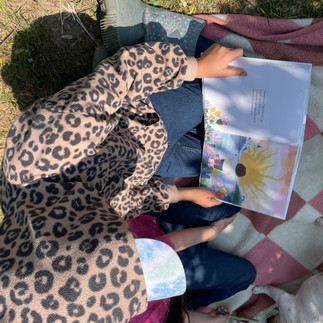
Poetry is like music, it flows and tickles the emotions. Poems are like nests, with words, ideas and dreams collected and woven together; molded and reworked until the form is just perfect. Today was all about gathering 'juicy' words using our five senses as a guide. It was a challenging project, but so worth it!

Every day nature school starts out with a fun, active challenge, and today was no different. Our animal was a large bird of the forest, who lives all year inside a few hectares of land. Who was this bird? (Ruffed Grouse). Ask for the sound it makes to attract a mate and imitation of the male strut. It will be quite a show! Now, predators love these ground nests. Who steals eggs and how might the female fend off an attack?

Let’s start with our sense of smell. What different scents were around the sensory garden? What combination of smell makes a pizza or a chocolate milkshake. Do you have a favourite smell? What words did we share that described some of these smells?
Everything at the farm is dry and we know that young roots are hungry for moisture. What trees are newly planted down by the willow structure? (White Cedar).
Oops, who almost got dumped out with the water?

Snack was the natural time to stretch our taste vocabulary. What tasty words does your child recall? (salty, oily, toasty, sour, minty). Our new book inspires the poet within us all. This author takes her big poem called 'the Nest', and uses words from it to create 160 more ‘nestling’ poems. We will share more from this collection and others that connect poetry and nature. Look for great reads, “My Thoughts Are Clouds” by Georgia Heard, with poems to cultivate mindfulness, and ‘Sometimes I Feel Like a River’ by Danielle Daniel. We hope to introduce these amazing new books another time.


To exercise our sense of hearing we sketched a sound map. Ask what sounds your child added, which were enjoyed or annoying. What words did we come up with to describe these sounds? (roaring, scratching, shaky, buzzing, musical). You might even see if you can get a redraw of their sound map from memory.
The Sneaky Trail leads through the meadow. We tested if this meadow space offered good protection to small mammals and birds. What was the test and result?

Camouflage is a little tougher to do now…why? We added a new rule which mimics what small prey animals do to check on predators. What is it? The open spaces in the fields are beautiful with soft wheat stalks underfoot.

What about our sense of touch? Did your child guess the four natural objects just from feeling with their fingertips? What were they?

Time to use our most practiced sense, the only one directly connected to our brain (thanks Daisy), our sight. A colour walk hones this sense by looking for the closest match on a paint palette. We know that paint colours have some pretty interesting names. After looking through our own catalogue of colours we were off on a partner hunt to find six different colours in nature and give them descriptive names. We really stretched our thinking on this by asking ourselves, what does this colour remind me of? A rusty car, hot chocolate with marshmallow, creamy sun, or a rocket ship. So much imagination is pulled out in this activity.

The final challenge was to create a colour poem using all our senses and the vocabulary we placed on the Poet-Tree. Daisy and I agree we will revisit this again as it was a BIG task. Feel free to do this as a home literacy activity, practice will make this much easier. We all have poetry within us. Offering this avenue of expression can change a life for some and open new windows on the world for others. Keep encouraging this full sensory expression through games, on walks, or over summer mealtimes together. Celebrate the opening of descriptive language and use of senses in getting to know the natural world and yourself.


So happy to have Daisy back! She loves the big open spaces at the farm and we LOVE having her to inspire our learning!

More fun next week with our our friends at the farm. See you then Forest Friends:)







































Comments